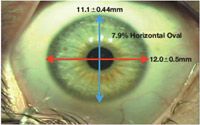Article
Making the case for oval flaps
With the latest-generation corneal femtosecond lasers, it is now possible to customize nearly every aspect of the flap, including shape.

Key Points

Recent investigations have shown at least three advantages to an oval flap: better correspondence to the anatomy of the cornea; more precise alignment of the flap after treatment; and a better match for the most common custom ablation pattern.

Cylinder axis role
Also intriguing is a recent report from Mandel and colleagues, in which they found that a majority of their large database of young subjects (16- to 22-yearolds) had "with-the-rule" (WTR) astigmatism.2
Although excimer laser platforms have become so advanced that we no longer need to analyze carefully the planned ablation pattern, most of us will remember that correction of the classic "bow tie" of WTR astigmatism yields an ablation pattern that is essentially oval-wider in the horizontal axis than in the vertical.
I decided to investigate the proportion of WTR astigmatism in my own patient population. In a large retrospective data set of 181,244 eyes with ≥1 D of astigmatism treated at TLC Laser Eye Centers in the past 10 years, 42.4% had WTR astigmatism (defined as plus cylinder within 15° of the 90° axis), 36.9% had oblique astigmatism, and only 20.7% had against-therule (ATR) astigmatism (defined as plus cylinder within 15° of the 180° axis).

Moreover, my data indicate that the prevalence of WTR astigmatism increases with higher myopia and higher levels of astigmatism (Figures 2 and 3). In all these patients, an oval bed best accommodates the custom ablations being performed.
Newsletter
Don’t miss out—get Ophthalmology Times updates on the latest clinical advancements and expert interviews, straight to your inbox.





